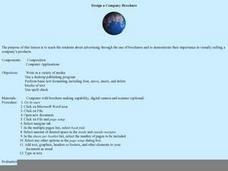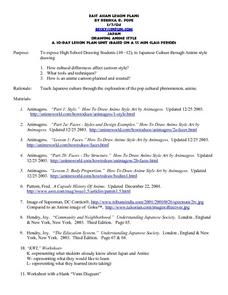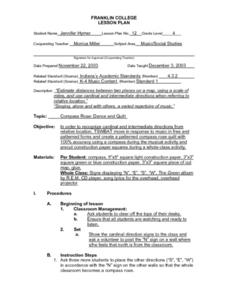Curated OER
An Encyclo-ME-dia for Every Child
Students create a digital scrapbook that shows information-text and pictures that are specific to each child. They make charts and graphs. They use digital cameras, scanners, software, to write captions, stories, poems, letters, and...
Curated OER
Shape Up!
Students investigate measurement through the use of literature through this series of lessons.
Curated OER
Design a Company Brochure
Students design a brochure using a publishing program. In this design lesson, students follow step-by-step directions to create a brochure advertising a product of their choice.
Curated OER
Properties of Magnets
Second graders read and discuss the book "What Magnets Can Do." They recall the explanations of magnet, attract, repel, and magnetic poles from their reading. They work in pairs to discover the properties of magnets using a magnet and...
Curated OER
During Reading Strategy for Charles Dickens’ Great Expectations
Readers create a literary scrapbook for one of the characters in Charles Dickens' Great Expectations and fill it with mementoes, journal entries, letters, etc. A great way to get kids to think about characterization.
Curated OER
Mississippi Trial, 1955: K-W-H-L Strategy
To prepare for a reading of Christopher E. Crowe's Mississippi Trial, 1955, class members create a KWHL chart and begin by generating questions they have about the civil rights movement, slavery, and the death of Emmett Till.
Brigham Young University
The Crucible: Problematic Situations
What would you do? To prepare for the final scene from Arthur Miller's The Crucible, readers are presented with a series of moral dilemmas and asked to consider what they would do in the same situations.
Center for the Advancement of Ethics and Character
Charlotte's Web: A Story About Friendship
Strengthen the bonds of friendship within your class with a reading of E.B. White's award-winning novel, Charlotte's Web. Focusing on the unique characters in the story and the relationships they develop, young readers draw from their...
Novelinks
The Little Prince: Response to Art Exercise
Depending on your perspective, solitude can be lovely or very, very lonely. Kids take a look at the simple landscape illustrated in Antoine de Saint Éxupery's The Little Prince, and write a short journal entry about their perception of...
Curated OER
Drawing Anime Style
Young scholars use a graphic organizer to explore the drawing style known as Anime. They conduct research from a variety of internet resources to come up with a better comprehension of the style and how it is drawn.
Curated OER
Compass Rose: Dance and Quilt
Fourth graders identify the cardinal directions by listening to a song entitled, "Stand," and by reviewing the lyrics to that song. They notice the cardinal directions that are posted around the classroom. They perform the motions as...
Curated OER
How Does Light Move?
Second graders investigate how light passes through objects, is blocked, bounces off of things, and bends. They discuss how light moves in different ways, and with a partner walk around the room with a flashlight, shining the light on...
Curated OER
Bimaadagaako Adventure
Students use an interactive website to complete a wilderness trail adventure where they learn about Native cultures, voyagers, and the Canadian fur trade. In this interactive history lesson, students visit the wilderness classroom...
Curated OER
Absolute and Relative Location
Second graders understand the difference between relative and absolute location using the grid map as an example of an absolute location. They observe a class map showing longitude and latitude lines and learn that they provide exact...
Curated OER
Clouds
Second graders construct the 3 types of clouds using cotton balls and write sentences describing them. In this clouds lesson plan, 2nd graders describe a cumulus, stratus, and cirrus cloud.
Orange County Department of Education
Dear Mr. Henshaw
Fifth graders read Dear Mr. Henshaw and identify the character trait of self-respect as exhibited by Leigh throughout the story. They evaluate the author's use of letters to tell the story and discuss how the story would be different if...
Curated OER
Compound Sentences
Third graders write sentences that have the same topic using a comma and and, as well as practice writing new compound sentences by combining five pairs of sentences on paper. They then work in pairs and take turns writing simple...
Curated OER
Trees of our Forests
Young scholars use a field guide in order to identify trees. In this trees lesson plan, students classify the trees that they identify based on their relationships. Young scholars take a trip outdoors to look at trees.
Curated OER
Golden Rule
First graders discuss how others should use the Golden Rule to peacefully solve real life problems. They perform short skits that depict people breaking the Golden Rule. They work as a class to determine ways the problem could be solved....
Curated OER
Seeing Numbers In Tens And Ones
Second graders develop the skill of place values up to the tens place. They practice identifying the values of 2 digit numbers and writing the correlating values with counting. They use the example of money to make the lesson more...
Curated OER
Exploring The Great Salt Lake
Second graders experiment with sand samples taken from a lake. They use this as part of an inquiry that is based on observations. The properties of the sand are observed in the lab and recorded in writing. Prior to the lab students...
Curated OER
Tracing the History Of Food
Students explore cultural variations in food preparation. They pick a country and research dishes of cultural significance. They prepare their food and present the dish to the class creatively.
Curated OER
Postcards For Your Ears
Here is a great way to have your students make audio postcards to share by recording a message on the computer. They write and revise an appropriate message about an object from home, choose a background, and font colors for the...
Curated OER
Living Organisms
Third graders examine pond water samples using hand lenses while working in small groups. They find specimens of living organisms in the water samples. Finally, the draw a picture of the organisms and label them using descriptive...

























